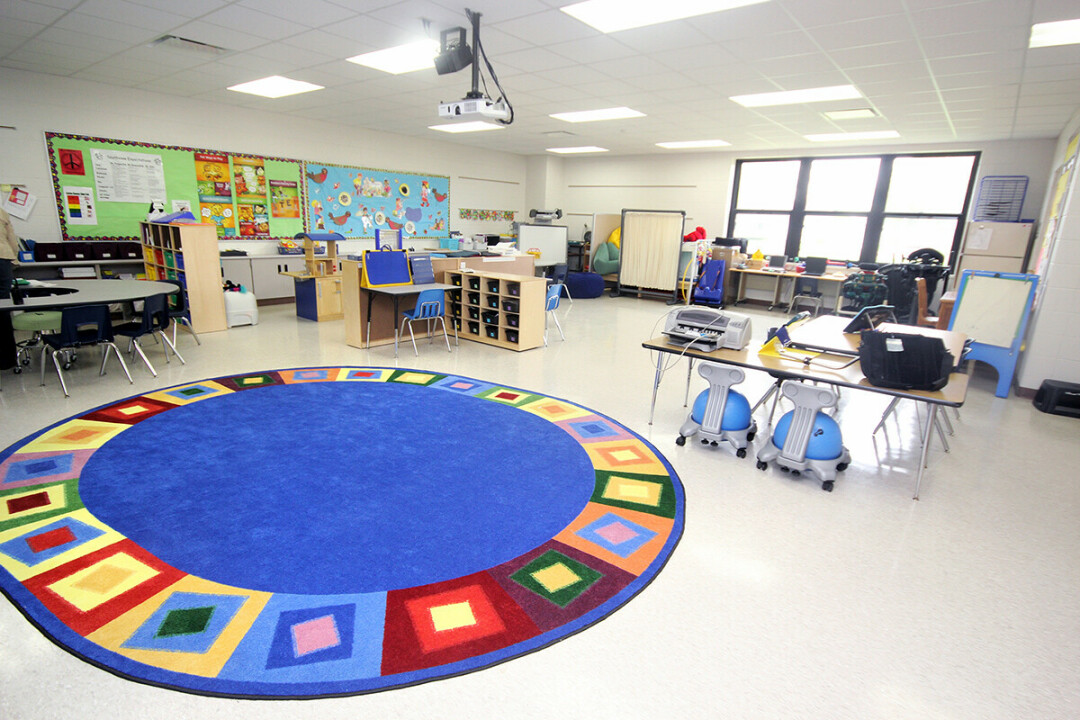Back to School Means Stepping Into the Unknown
Chippewa Valley students, parents, and schools navigate a changed world
Tom Giffey, photos by Andrea Paulseth |

In addition to crayons, colored pencils, and composition notebooks, this year’s back-to-school shopping lists include something previously unthinkable: face masks.
Welcome to the 2020 school year, where the normal end-of-summer combination of excitement is tempered with the worry of sending children back to school amid a global pandemic. That’s what families in the Chippewa Valley are poised to do in the coming weeks, with most districts beginning classes Sept. 1.
“Everything is kind of a lose-lose,
it’s just a matter of what do we lose and how much.” –Tim Nordin,
Eau Claire school board president
Depending on the district and their families’ choices, going back to school will mean five days a week – or maybe two or three or four – in the classroom, wearing a state-mandated mask, or perhaps studying virtually from home.
“Everything is kind of a lose-lose, it’s just a matter of what do we lose and how much,” Tim Nordin, president of the Eau Claire school board, said when asked about the board’s options for the fall semester. “The more we go back to school, we lose some physical safety from the pandemic. But when we stay home from school, those kids lose some safety at home and the opportunity to interact with their friends, the social and emotional security.”
In July, Nordin and the majority of his fellow board members chose to adopt a blended model – which Nordin, a parent himself, called “the best of a bad situation” – which will see most kids in school two days a week and at home three days. (Other districts adopted different approaches, some of which are outlined in this related article.)
On the whole, based upon their enrollment decisions and responses to a survey earlier in the summer, Eau Claire parents have indicated they want at least some in-person education this fall, despite the pandemic. But that doesn’t mean they’re not asking questions about the coming school year – questions that can’t all be answered yet.
Families will learn the week of Aug. 17 which days of the week their children will be in school. They already know their kids will be wearing masks, will be physically distanced from each other, and won’t be playing organized sports.
“(Parents want to know) that they’re not flying blind like they felt like they were in the spring, and we were putting the plane together while we were flying it in the spring,” Nordin said. “Teachers did a fantastic job, but there were cracks, because we were not prepared to do this.”
Nordin stressed that, when it comes to COVID-19, the school district is relying on the expertise of the Eau Claire City-County Health Department. “We want to be able to be flexible and nimble to keep our students and staff as safe as possible in the event there’s an outbreak,” he said.
NEW SUPERINTENDENT
Michael Johnson stepped into uncertainty when he began his new job as Eau Claire school district superintendent amid the pandemic. “It’s my 28th year in education, but there are many times where I feel like it’s my first day on the job,” Johnson said of leading the district in this unprecedented time.
Johnson – who most recently was assistant superintendent of South Washington County Schools in the Twin Cities metro area – officially began July 1, replacing the retiring Mary Ann Hardebeck.
While echoing Nordin’s assessment that “there aren’t any great options” when it comes to reopening schools, Johnson said cooperation with health department guidelines will keep students and staff as safe as possible.
“I really have so much faith in the community, and we’ve got outstanding teachers, families, students, and we’re going to do the best we can because we’re working on this together.” –Michael Johnson, Eau Claire school district superintendent
While he’s only been in Eau Claire a few weeks, he’s already heard plenty from teachers, parents, and students – not all of whom agree with the district’s approach. “We are not going to make everyone happy, but one thing we can do is we can make sure everyone has as much information as possible, and that’s our goal,” he said.
In addition to taking steps to mitigate the risk of the virus spreading in schools, the district is trying to address other concerns, too, including the digital divide that may keep some children from learning at home. Johnson said all students will have a new digital device to take home with them this fall, and the district will also provide wireless hotspots for those who don’t have Internet access at home. Efforts are also being made to accommodate children who rely on free school lunches, as well as those who are English-language learners or who have special educational needs and may need to be physically in school more than two days a week.
Johnson said he expects the state Department of Public Instruction and the Department of Health Services to create guidelines for when and if a classroom or school would be shut down because of a COVID-19 outbreak. He emphasized that the district will work closely with the health department in the event someone in the school tests positive for the virus. In such a situation, the health department would notify those who were in contact with the person. (In other words, if there’s a case in a school, trust what you hear from the health department, not the rumor mill.)
Johnson praised the more than 250 school staff and community members who have worked together on a reopening task force. “I really have so much faith in the community, and we’ve got outstanding teachers, families, students, and we’re going to do the best we can because we’re working on this together,” he said.
PARENTAL PERSPECTIVE
This summer, Eau Claire parents have faced the difficult decision of choosing a path for their children.
According to the school district, more than 80% opted for the hybrid model, under which most kids will go to school two days a week. That’s what Shannyn Pinkert, a mother of two middle-schoolers, chose – but it’s not a worry-free path.
“I’m a whole ball of emotions right now,” she said. “I have joined a lot of parents in that whole circle grief.”
And yet she believes having in-person contact with teachers and peers is important for her children. “I never signed up to be a teacher,” she said. “I don’t have the personal patience for it. … My children are better served where there is a teacher there to help them.”
While she wishes she could answer all of her children’s questions about the coming year, Pinkert said she recognizes that school officials are doing their best. “I think we all just have to remember and put ourselves in their shoes,” she said. “They’ll get the answers when they have them.”
“All of us are doing this for the first time, and we all need to go into it with the very best of intentions and work on this together.” –Mark Goings,
president, Eau Claire Association of Educators
About 18% of Eau Claire school district parent opted for fully virtual education for the coming year. Among them are William Kampf, a father of two elementary students, who doesn’t believe schools can be opened safely because of the virus. “It is a dangerous game of chance the school district is playing with too many people’s lives,” he said. “They should have prepared for a 100% virtual option back in April or May, but it feels like they were waiting for the county or state or federal government to close the schools again so they wouldn’t have had to make the decision themselves.”
Kampf considers his family fortunate to be able to educate their children at home. “We learned some lessons from the shutdown in March regarding how we will handle working from home while fostering a productive learning environment, but we understand the challenges ahead and know it won’t be easy,” he said.
Overall, while Kampf wouldn’t have chosen the scenario under other circumstances, he hopes that his children can take life lessons from what is going on around them. “We’re hoping to use this rare event to teach our children that nothing in life is guaranteed and there will always be unforeseen obstacles,” he said.
TEACHER WEIGHS IN
Kids and parents aren’t the only ones feeling butterflies about the first day of school. “From a teacher’s standpoint, the start of the school year is always exciting and has those unknowns. This year it is that feeling times 10 or times 100,” said Mark Goings, president of the Eau Claire Association of Educators and a resource teacher at Robbins Elementary.
Every one of the district’s teachers is learning how to teach in a new format, whether it’s blended or entirely virtual. Eau Claire school district families were asked to decide by Aug. 5 whether they wanted their children to have hybrid or virtual-only education. After that date, about 2,000 families still hadn’t responded to the survey, Goings said.
Goings noted that many of the district’s elementary schools were already dealing with capacity issues, which has made it challenging to find the additional space needed to physically distance students within classrooms. A space audit earlier this summer identified alternate spaces – such as libraries and gymnasiums – that might be used as classrooms.
“There’s all these variables that are all being figured out at the same time,” he said. “On one hand you’re trying to figure out how you find the space for all these classrooms, but you also don’t know how many people are going to be there in person.”
Because adjusting to the coronavirus will mean smaller in-person class sizes and (at the middle and high school levels) longer class periods, offering teachers the opportunity to do things they might not have had time to do in the past, Goings said.
Once the school year begins, flexibility will be key, Goings emphasized. “There will be things that will change from Sept. 1 through the end of the month, and what it looks like in October and November may also look different,” he said, noting educational methods will likely evolve, as will our understanding of best practices to limit the spread of COVID-19.
Schools will also have to be nimble in reacting to viral hotspots. “One thing that we’ve already seen nationwide is there are certain schools that have opened and in fairly quick order have had to close because, for whatever reason, there were health issues that start to arise,” Goings said.
Ultimately, Goings concluded, communication and understanding will be vital. “All of us are doing this for the first time, and we all need to go into it with the very best of intentions and work on this together,” he said.





















